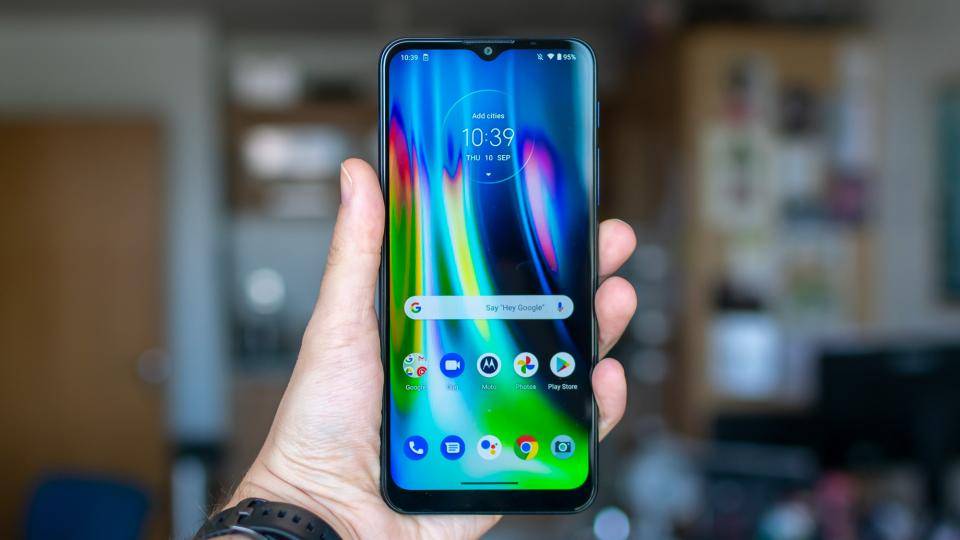Clearly, the Covid-19 pandemic hasn’t interrupted Motorola’s usual barrage of smartphone launches. With a familiar smattering of devices in the budget tier, as well as a few tentative steps at re-entering the premium portion of the market, Motorola’s continuing smartphone launch strategy is focused on hurling as many handsets on to shop shelves as possible and seeing what sticks.
READ NEXT: The best budget smartphones
Indeed, landing a mere six months after the release of the Moto G8 , the G9 series of phones have already begun to emerge, with the recently announced Motorola Moto G9 Play being among the first to appear. Bizarrely, though, this seems simply to be a re-branded Moto G9, with exactly the same specs as the handset that launched in India just one day prior. Does this mean that there will be no Moto G9 coming to Europe? Your guess is as good as mine.

Motorola Moto G9 Play review: What you need to know
Moniker mixups aside, the Motorola Moto G9 Play improves upon its predecessor, the Moto G8, in a number of ways. With a new design, an upgraded Qualcomm Snapdragon 662 processor and the addition of NFC, the Moto G9 Play is a bit of a step-up in value terms.

Although hardly surprising when you consider that the Moto G9 Play is the very definition of a budget phone, a few cutbacks still remain in place in order to keep the price down. The IPS display – while slightly larger at 6.5in – is still only a 720p (HD+) affair, and the G9 Play lacks the fancy features usually found in its pricier stablemates, such as IP-rated waterproofing, 4K video recording and 5G connectivity.
Motorola Moto G9 Play review: Price and competition
If these are features you can’t live without, then you might be better off spending more money, since this is the stuff usually reserved for the upper echelons of the smartphone space. With regards to the Moto G9 Play, however, it’s actually quite well-configured for the price, and it’s £20 cheaper than the price the Moto G8 launched at just six months ago. At the time of writing, the G9 Play on trial here will set you back £160.

It’s pretty much the same price as the Moto G8 these days, however, and when you take into account the added extras this represents exceptional value for money.
On the other hand, you won’t be hard-pressed to come up with a list of similarly-priced alternatives. The budget end of the phone spectrum has exploded in popularity in recent years, with our current favourites being the Samsung Galaxy A21s ( £150 ), Nokia 5.3 ( £130 ) and Xiaomi Redmi Note 9 ( £199 ). We also have the Xiaomi Poco X3 NFC (£199) in for review, which could be another solid contender for the budget crown.
Motorola Moto G9 Play review: Design and key features
In design terms, Motorola has mixed up the formula again, most notably when it comes to the rear camera placement. Now situated in a neat square in the top-centre portion of the phone, the three cameras and LED flash module are spaced evenly apart in a 2x2 grid, with a sensibly-placed circular fingerprint reader – with the Motorola “M” logo etched onto it – sitting just underneath.
It’s certainly a tidy look compared with the Moto G8’s somewhat clumsy camera placement, and I especially like the two new colour choices on offer. I was sent the “Sapphire Blue” model for review, which has a subtle gradient finish that changes from a dark blue to a lighter hue from the edges of the handset towards the middle. There’s also a “Forest Green” variant, which judging by the press images is just as eye-catching.
On the front of the phone, the Moto G9 Play has a simple teardrop notch nibbling its way into the top-centre portion of the screen, which houses the 8MP front-facing camera. This has also moved positions: the Moto G8 instead incorporated a hole-punch camera in the top right corner.
The 6.5in screen is mostly bezel-free, with slim black bars across the top and side edges, although there is a comparatively chunky chin bezel at the bottom. The handset’s dimensions are rather brutish, too, with the Moto G9 Play’s 9.2mm thickness and 200g heft presumably as a result of its massive 5,000mAh battery and large display.
Build quality, however, is impressive and its hardy construction is reminiscent of much pricier handsets, with minimal flex or bending when placed under pressure. It’s worth bearing in mind, though, that the Moto G9 Play doesn’t have a protective layer of Gorilla Glass on either the front or back, nor does it have any official IP-rated dust or water ingress protection. It’s best to keep this phone away from the elements, or pop it in the supplied clear plastic case if you’re a bit clumsy.
A key part of the Moto G9 Play’s appeal, however, is the inclusion of NFC. Making a welcome return following its removal in the previous generation, the Moto G9 Play can be used for contactless payments, “tapping” in and out at London Underground ticket gates and the like, without having to pull your wallet from your pocket. Sure, NFC is largely an expected requirement these days but many budget phones still don’t support this feature.
Motorola Moto G9 Play review: Display
The Moto G9 Play is a bit dated in the display department, though. With Full HD handsets coming from the likes of Xiaomi, Realme and Samsung in this price bracket, the Moto G9 Play simply makes do with a 720 x 1,600 (HD+) IPS panel, stretched across a large 6.5in screen. It could be worse, of course – I remember when 720p was as good as it got – but the Moto G9 Play’s screen doesn’t hold up quite as well under scrutiny.
Our display calibrator reported an sRGB gamut coverage of 84% in the phone’s “Natural” display setting, with a total volume of 90%. Colour accuracy is a bit off, too, with an average Delta E of 2.65 (the lower the better), and it doesn’t get particularly bright either, with a measured peak luminance of 376cd/m².
The two other display modes on offer – “Saturated” and “Boosted” – tinker with the vibrancy of certain colour tones but these are a bit too saturated and candy-coloured for my tastes. One saving grace, however, is that the Moto G9 Play’s contrast ratio is rather good, at a measured 1,999:1.
Motorola Moto G9 Play review: Performance and battery life
As for the Moto G9 Play’s internals, it uses a Qualcomm Snapdragon 662 chipset, which from a technical standpoint is pretty much identical to the Snapdragon 665 that powered the Moto G8. Like the 665, the 662 is an octa-core processor clocked at 2GHz and is built on an 11nm fabrication process. The comparisons between both phones don’t stop there either: the Moto G9 Play also has 4GB of RAM, alongside 64GB of expandable storage.
It comes as no surprise, then, that performance is practically identical between the two models. Running the Geekbench 5 single- and multi-core CPU tests, the Moto G9 Play achieved the same score as the Moto G8 , as well as the other Snapdragon 665 phone on the list, the Nokia 5.3 . The only phone it managed to pull away from was the Samsung Galaxy A21s and its Exynos 850 chipset.
Generally speaking, performance is actually rather good. There may not be a boost in processing speed, but it could be argued that the Moto G9 Play doesn’t really need it: launching apps felt snappy and I didn’t run into any problems when navigating menus or switching between applications.
Gaming performance is yet another area where the Moto G9 Play runs neck and neck with its rivals. The GFXBench Manhattan 3 on-screen benchmark revealed similar average frame rates to the Moto G8 and Nokia 5.3, at a respectable 33fps. Thanks to the phone’s low 720p resolution display, most games on the Google Play Store should run fine.
When it comes to battery life, however, that’s when the Moto G9 Plus begins to pull ahead. Lasting 19hrs 46mins on a single charge in our video rundown test, the Moto G9 Plus’ stamina is increased by roughly 8% when compared with the Moto G8, and it lasted longer than both the Nokia 5.3 and Xiaomi Redmi Note 9 .
Motorola Moto G9 Play review: Cameras
As for the cameras, the Moto G9 Play uses a triple-camera array on the rear. The primary snapper is a 48MP (f/1.7) affair, and this is complemented by a 2MP (f/2.4) macro and a 2MP (f/2.4) depth-sensing unit. Eagle-eyed readers might have noticed that the depth sensor actually replaces the Moto G8’s wide-angle camera, which is a bit of a shame. In my view, the option to squeeze more stuff in the frame is more beneficial than any marginal gains achieved by a depth sensor.
Like the Moto G8, camera performance is a bit of a mixed bag. The Moto G9 Play’s main camera takes 12-megapixel still images (via a process called pixel binning) and, as far as I could tell, there’s no option to take a full 48MP image. Provided you’re graced with plenty of light, still images look quite lovely for the price, with a decent amount of detail and clean, neutral-looking colours.
The Moto G9 Play isn’t very good at accurately judging exposure levels, however, and I often had to use the on-screen exposure slider to boost the overall brightness of a photograph. Low-light performance is pretty dire, too, with a noticeable amount of visual noise and a distractingly warm hue to images shot indoors under less than ideal lighting.
As for the other cameras, the macro unit allows you to get up to 4x closer to your subject than the regular snapper, capturing finer details up close. It’s fun to use, but results are variable. It was a particularly windy day when I was testing this feature for my review, and the camera struggled to focus on the quivering flowers in the garden.
I’ve already cast shade on the depth camera but, for the most part, any portrait images you take look pretty good and you can even adjust the level of background blur after you snap the image.
Finally, the Moto G9 Play can only record video at up to 1080p (Full HD) resolution at 30fps. There’s no option to record at 60fps or higher resolutions but the footage is fully stabilised at least.
Motorola Moto G9 Play review: Verdict
Looking back through the sections of this review, it's clear that the Moto G9 Play absolutely hits the nail on the head in a number of areas but that it also fails to represent a notable improvement on the Moto G8, which launched only six months prior.
With respectable performance, subtle design changes, a slightly improved battery life and the return of NFC, the Moto G9 Play is still a standout phone in the budget category.
However, since the addition of NFC is the only meaningful upgrade, the Moto G9 Play feels a bit too samey for my liking. If you do decide to buy one, then it should serve you well enough, but if you only recently picked up a Moto G8 , then you aren’t really missing out on much.
|
Motorola Moto G9 Play specifications |
|
Processor |
Octa-core Qualcomm Snapdragon 662 (4x2GHz, 4x1.8GHz) |
|
RAM |
4GB |
|
Screen size |
6.5in |
|
Screen resolution |
1,600 x 720 |
|
Pixel density |
270ppi |
|
Screen type |
IPS |
|
Front camera |
8MP (f/2.2) |
|
Rear camera |
48MP (f/1.7), 2MP (f/2.4) macro, 2MP (f/2.4) depth |
|
Flash |
LED |
|
Dust and water resistance |
No |
|
3.5mm headphone jack |
Yes |
|
Wireless charging |
No |
|
USB connection type |
USB-C |
|
Storage options |
64GB |
|
Memory card slot (supplied) |
microSD |
|
Wi-Fi |
802.11ac |
|
Bluetooth |
5 |
|
NFC |
Yes |
|
Cellular data |
4G |
|
Dual SIM |
|
Dimensions (WDH) |
165 x 76 x 9.2mm |
|
Weight |
200g |
|
Operating system |
Android 10 |
|
Battery size |
5,000mAh |
